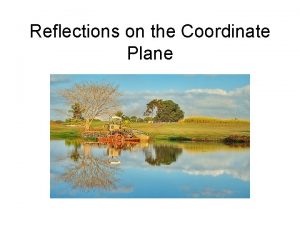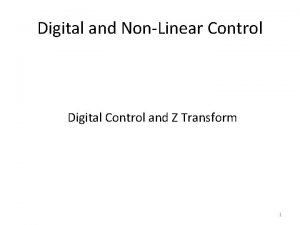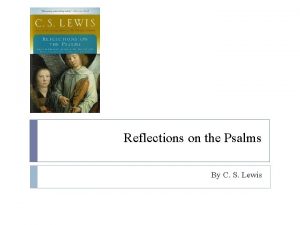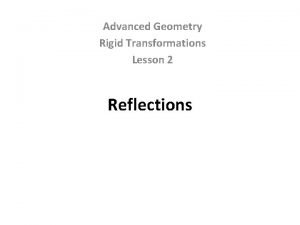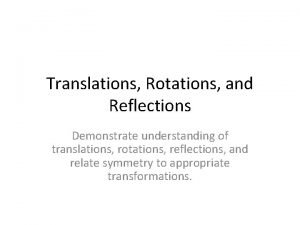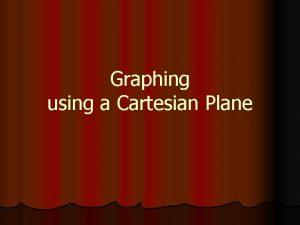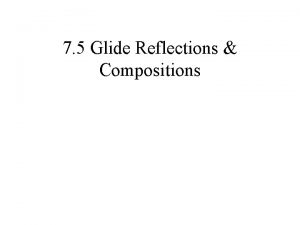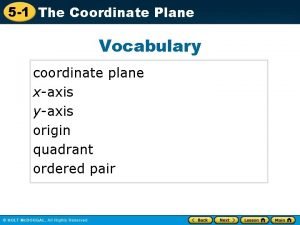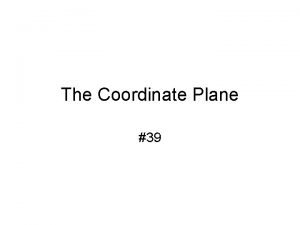7 2 Reflections Using Reflections in a Plane





















- Slides: 21

7. 2 Reflections

Using Reflections in a Plane • One type of transformation uses a line that acts like a mirror, with an image reflected in the line. • This transformation is a reflection and the mirror line is the line of reflection.

Using Reflections in a Plane • 1. A reflection in a line m is a transformation that maps every point P in the plane to a point P′, so that the following properties are true: If P is not on m, then m is the perpendicular bisector of PP′.

Using Reflections in a Plane • 2. A reflection in a line m is a transformation that maps every point P in the plane to a point P′, so that the following properties are true: If P is on m, then P = P′

Example 1: Reflections in a Coordinate Plane • Graph the given reflection. a. H (2, 2) in the x-axis b. G (5, 4) in the line y = 4

Example 1: Reflections in a Coordinate Plane • Graph the given reflection. a. H (2, 2) in the x-axis Solution: Since H is 2 units above the x-axis, its reflection, H′, is two units below the x-axis

Example 1: Reflections in a Coordinate Plane • Graph the given reflection. b. G (5, 4) in the line y = 4 Solution. Start by graphing y = 4 and G. From the graph, you can see that G is on the line. This implies G = G′

Properties of Reflections in the coordinate axes have the following properties: 1. If (x, y) is reflected in the x-axis, its image is the point (x, -y). 2. If (x, y) is reflected in the y-axis, its image is the point (-x, y). In Lesson 7. 1, you learned that an isometry preserves lengths. Theorem 7. 1 relates isometries and reflections.

Theorem 7. 1 Reflection Theorem • A reflection is an isometry • What is an Isometry?

Prove it. • To prove the Reflection Theorem, you need to show that a reflection preserves the length of a segment. • Consider segment PQ that is reflected in a line m to produce P′Q′. The four cases to consider are shown below. P and Q are on the same side of m. CASE 1

Prove it. • To prove the Reflection Theorem, you need to show that a reflection preserves the length of a segment. Consider segment PQ that is reflected in a line m to produce P′Q′. The four cases to consider are shown below. P and Q are on opposite sides of m. CASE 2

Prove it. • To prove the Reflection Theorem, you need to show that a reflection preserves the length of a segment. Consider segment PQ that is reflected in a line m to produce P′Q′. The four cases to consider are shown below. CASE 3: One point lies on m and PQ is not perpendicular to m.

Prove it. • To prove the Reflection Theorem, you need to show that a reflection preserves the length of a segment. Consider segment PQ that is reflected in a line m to produce P′Q′. The four cases to consider are shown below. CASE 4: Q lies on m and PQ m.

Reflections and Line Symmetry • A figure in the plane has a line of symmetry if the figure can be mapped onto itself by a reflection in the line. • Example 4: Finding Lines of Symmetry Hexagons can have different lines of symmetry depending on their shape.

Reflections and Line Symmetry This hexagon has one line of symmetry.

Reflections and Line Symmetry This hexagon has four lines of symmetry.

Reflections and Line Symmetry This hexagon has six lines of symmetry.

Ex: 5 – Identifying Reflections • Kaleidoscopes: Inside a kaleidoscope, two mirrors are placed next to each other to form a V as shown to the right. The angle between the mirrors determines the number of lines of symmetry in the image. The formula below can be used to calculate the angle between the mirrors, A, or the number of lines of symmetry in the image, n. angle n ( m A ) = 180° black glass

Now what? • Use the formula to find the angle that the mirrors must be placed for the image of a kaleidoscope to resemble a design. There are 3 lines of symmetry. So you can write 3( m A) = 180° 3 x = 180 X = 60°

Now what? • Use the formula to find the angle that the mirrors must be placed for the image of a kaleidoscope to resemble a design. There are 4 lines of symmetry. So you can write 4( m A) = 180° 4 x = 180 X = 45°

Now what? • Use the formula to find the angle that the mirrors must be placed for the image of a kaleidoscope to resemble a design. There are 6 lines of symmetry. So you can write 6( m A) = 180° 6 x = 180 X = 30°
 Data plane control plane and management plane
Data plane control plane and management plane Reflection over x axis
Reflection over x axis Reflect
Reflect Voice localization using nearby wall reflections
Voice localization using nearby wall reflections 후크의 법칙
후크의 법칙 Forward equivalence class
Forward equivalence class Z transform is a non-linear operation
Z transform is a non-linear operation Drawing auxiliary view using center plane reference
Drawing auxiliary view using center plane reference Defrost using internal heat is accomplished using
Defrost using internal heat is accomplished using Using system.collections
Using system.collections Reflections on the psalms
Reflections on the psalms Reflections
Reflections Reflections lesson 2-2
Reflections lesson 2-2 Reflections copenhagen
Reflections copenhagen Practice 9-6 compositions of reflections answers
Practice 9-6 compositions of reflections answers Georgia pta reflections
Georgia pta reflections Mirror of guarding reflections
Mirror of guarding reflections Retail reflections
Retail reflections Translations rotations and reflections
Translations rotations and reflections Reflections gcse art
Reflections gcse art Silver jubilee reflections
Silver jubilee reflections Horizontal and vertical reflections
Horizontal and vertical reflections

